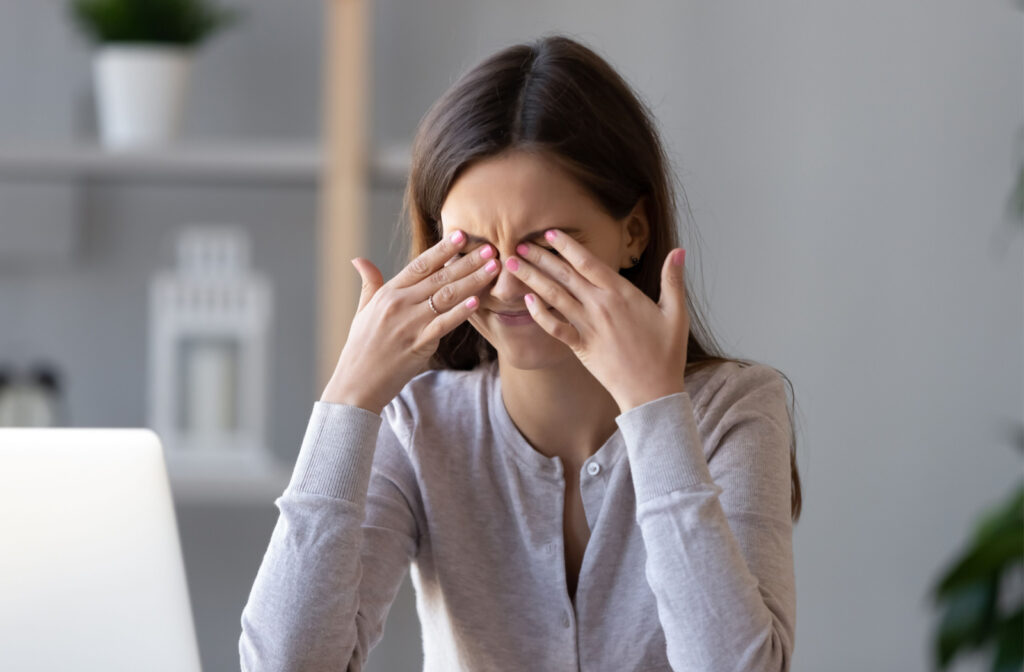If you experience tired and strained eyes after using digital screens for a long time, it may be a common condition called digital eye strain. Digital eye strain happens when you use digital screens like computers, smartphones, and tablets for an extended period of time.
Eye strain can diminish within 1 hour of stopping to use a screen. However, the duration of eye strain can vary from person to person and depends on factors such as the extent of screen exposure, individual eye health, accompanying symptoms, and the effectiveness of adopted relief measures.
For minor or severe eye strain or discomfort, contact your eye doctor. Regular eye exams can help maintain healthy eyes and detect early signs of vision problems before they worsen.
What Is Eye Strain?
Eye strain occurs when you spend long periods on near-focused activities, such as watching TV, reading, or staring at digital screens. As screens dominate our daily lives, it’s no surprise that eye strain has become a prevalent concern.
During near-focused work, your eye muscles naturally contract. However, prolonged contraction means your eyes don’t get a chance to relax, leading to eye fatigue and eye strain.
Eye strain and eye fatigue can also result from less blinking. Blinking helps maintain a smooth and moist eye surface.
Reduced blinking during prolonged screen time causes increased evaporation of tears and results in dry eyes and blurry vision. When your eyes put in the extra effort to maintain a clear viewing image from lack of lubrication, it can lead to visual fatigue and strain on your eyes.
How Long Does Eye Strain Last?
Eye strain typically doesn’t last for very long. However, it can depend on the time spent in front of a screen, if you have a vision condition, like a refractive error, or an underlying eye disease that can worsen your symptoms.
Typically, eye strain will subside within an hour after you stop using a digital device. However, accompanying symptoms, such as a headache, neck pain, or dry eyes, may take longer to go away. If you’re concerned about your symptoms or if they persist or worsen, speak to your eye doctor.
Digital Eye Strain
Digital eye strain, also called computer vision syndrome, refers to eye and vision problems related to prolonged use of digital devices. Digital eye strain symptoms can range from mild discomfort to more severe issues, affecting your vision quality.
Digital Eye Strain Symptoms
Recognizing digital eye strain symptoms is crucial in addressing eye strain and finding relief. Eye strain symptoms can resemble other vision conditions, making eye exams vital in ruling out underlying causes.
Symptoms of eye strain can include the following:
- Red eyes
- Excess tearing
- Irritated eyes
- Tired or sore eyes
- Blurred vision
- Mild headache
- Double vision
- Dry eyes
- Shoulder and neck pain
One of the most common symptoms of digital eye strain is blurred vision. Staring at screens for extended periods can cause your eyes to lose focus. If you’re squinting or rubbing your eyes frequently, it might be time to give them a break.
If you experience tired, achy eyes after a long day of screen time, you’re not alone. Eye fatigue is a prevalent symptom of digital eye strain, often accompanied by eyelid heaviness or soreness around the eyes. This discomfort can impact your overall productivity and daily activities.
Digital Eye Strain Management & Relief
Reducing screen time is not always an option due to learning or work reasons. However, you can incorporate several strategies and tips into your daily routine to relieve digital eye strain and manage your symptoms.
Take Frequent Breaks
To prevent prolonged strain, adopt the 20-20-20 rule—take a break every 20 minutes and look at something 20 feet away for 20 seconds. This brief pause allows your eye muscles to relax and reduces the risk of developing eye strain.
Adjust Screen Settings
Optimizing your digital devices to reduce eye strain can include adjusting the screen brightness, contrast, and font size to create a more comfortable viewing experience. You can also position your screen at eye or slightly below eye level and greater than arm’s length to minimize eye strain.
Use Artificial Tears
Dry eyes often accompany digital eye strain. Combat this by using artificial tears or lubricating eye drops. These can help keep your eyes moist and alleviate discomfort. Make sure to consult your eye doctor on which eye drops to use.
Blink Regularly
Blinking is a natural way to refresh and lubricate your eyes. However, many people blink less frequently when using digital devices, leading to dryness and irritation. Make a conscious effort to blink regularly, especially during prolonged screen sessions.
Reduce Blue Light Exposure
Blue light can affect your sleep-wake cycle. To limit your blue light exposure at night, use built-in blue light filters or blue light glasses, and stop using digital devices one hour before bedtime.
Have Regular Eye Exams
An uncorrected eye prescription can cause discomfort and eye strain when using digital screens. Visit your eye doctor regularly to check for underlying problems like prescription changes and discuss your options for glasses, specialized lenses, or contact lenses.

Get Help with Digital Eye Strain
In the hustle and bustle of our technology-driven lives, understanding and addressing digital eye strain is paramount for maintaining eye health. While the duration of eye strain can vary, management and relief strategies can significantly minimize digital eye strain symptoms for a more comfortable and productive digital experience. If you experience vision changes, book an appointment with EyeCare Niagara for personalized treatment and recommendations tailored to your needs.




